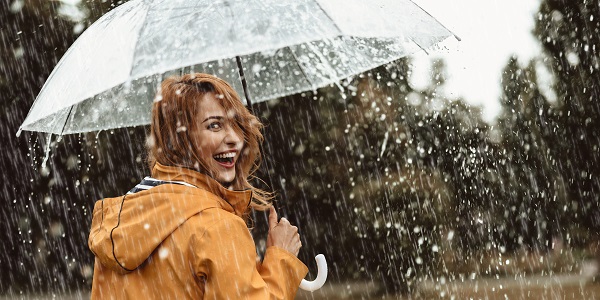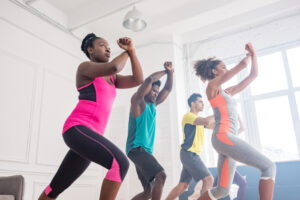Don’t let the cold, wetter weather stop you from enjoying all that the outdoors has to offer. You can start with this quick, easy workout that can be done in the wettest of weather! Just make sure you have an umbrella with you and head outside.
 Umbrella Squat Pops
Umbrella Squat Pops
Holding your umbrella up in one hand, lower down into a squat, and then pop up. For an added challenge, jump up from the squat position, clicking your heels together in the air, and then drop back down into a squat!
Single-leg Squat:

Holding your umbrella high (helps with balance!), head up, spine long, lift one leg off the ground. Bend your opposite knee to lower yourself toward the ground, lowering as far as comfortable without dropping your head (or your umbrella!).
Umbrella Chops:
 Start with the feet a little wider than hip-distance apart, keeping the knees slightly bent, and bring your umbrella to your left shoulder. Keep your core tight, “chop” your umbrella down diagonally across your body toward your right knee. Imagine you’re chopping some wood at this angle and your umbrella is your axe. With control, return your umbrella to the starting position, and then switch sides.
Start with the feet a little wider than hip-distance apart, keeping the knees slightly bent, and bring your umbrella to your left shoulder. Keep your core tight, “chop” your umbrella down diagonally across your body toward your right knee. Imagine you’re chopping some wood at this angle and your umbrella is your axe. With control, return your umbrella to the starting position, and then switch sides.
Puddle Run (fast feet):
 Start with your feet shoulder-width apart, and hips low. Holding your umbrella up with both hands, start running on the spot as quickly as you can, maintaining a neutral spine and core tight.
Start with your feet shoulder-width apart, and hips low. Holding your umbrella up with both hands, start running on the spot as quickly as you can, maintaining a neutral spine and core tight.
Before you head out to try one of these fun outdoor workouts consider the following:
Clothing
Working out in cold, wet weather requires some special care. When selecting clothing, consider choosing base layers (closest to the skin) made from synthetic fibers. Synthetic fibers wick moisture away from the body, keeping you dryer, longer. Avoid wearing a bulky outer coat as they can trap moisture. Instead, add an outer moisture barrier like a lightweight nylon shell or vest and dress in layers, removing layers as needed. When we exercise, our blood volume is directed toward our working muscles, so don’t forget to wear a hat and gloves to keep your extremities warm and comfortable.
Footwear
When exercising outdoors, choose footwear that ensures good traction and allows for ease of movement. Running shoes can be a great choice, as they can provide good traction, but they are designed to release heat, so consider adding shoe covers (available at running/outdoor active living stores) or wearing thermal socks to keep your feet warm, dry and comfortable.
Exercise prep
Allow extra time for a proper warm-up. Like your car, as the temperature falls, your muscles and supporting tissues require a little more time to get revved up. Include warm-up movements that are dynamic (moving) that mimic the exercises you intend to perform during your workout and that increase your range of motion so that you can get the most out of your workout.
Hydration
Most of us know that sweating means we are losing water and need hydration, but did you know that your body needs more hydration when you exercise in colder temperatures? Don’t forget to grab water on your way out to ensure you have the hydration you need to perform at your best!
Breathing
Cold air is drier, and your airways need moisture to function properly. Nasal breathing is always recommended, as your nose filters, moistens and heats the air you breathe, but can be difficult to maintain as exercise intensity increases. Covering your mouth and nose is a great way to increase moisture, and makes it more comfortable for you to breathe, helping you get the most out of your workout!



 Umbrella Squat Pops
Umbrella Squat Pops




